 Web Front-end
Web Front-end
 PS Tutorial
PS Tutorial
 PS web design tutorial - Tips: Create a countdown number board in PS in five steps
PS web design tutorial - Tips: Create a countdown number board in PS in five steps
PS web design tutorial - Tips: Create a countdown number board in PS in five steps
This tutorial shows how to design a countdown number card in PS, as shown in the picture below
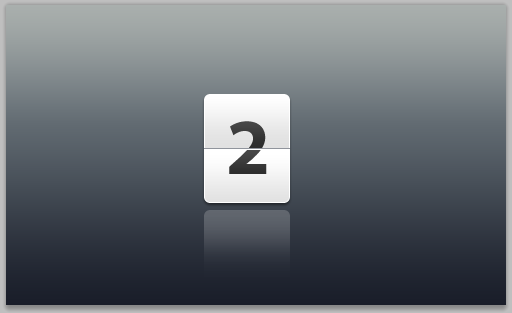
This kind of number card can currently be used on many occasions You can see it, especially on the now popular Android mobile phone system.
1. Setting up the Photoshop file
1. Configure Photoshop files
1.1. Create a new file (Ctrl + N). In the New file dialog box, set the Width and Height units to pixels (if it isn't already). Set the width to 500 and the height to 300 pixels. We're creating a graphic element for web, as mentioned above, so set the Resolution to 72 pixels/inch, color mode to RGB color , 8 bit and background contents to white.
1.1 Create a new file (Ctrl+N). On the new file window, set the width and height units to pixels (if not pixels). Set the width to 500 and the height to 300. To create image elements for use on the web page, as mentioned above, set the resolution to 72 pixels/inch and the color mode to RGB color, 8-bit. The background content is white
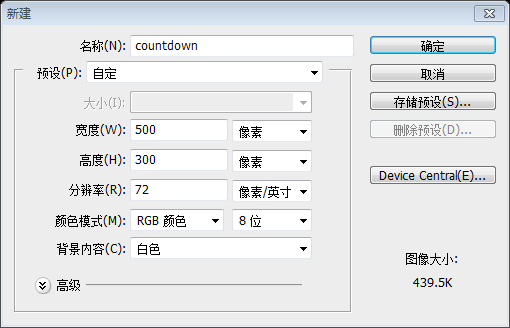
1.2. To unlock the layer, currently titled "background", double click on it and on appearance of a dialog window showing title as Layer 0, press ok.
1.2 Unlock the layer, the current title is "Background", double-click the layer, the title displayed on the dialog window that appears is changed to " Layer" and press OK

2. Adding color to the background (Layer)
2. Add background color (layer)
2.1. Select Layer 0 (if not already selected) and go to Layer > Layer Style > Gradient Overlay.
2.1Select "Layer" (if it is not selected), then click: Layer> Layer Style> Gradient Overlay
2.2. Make sure the opacity is 100%, style is linear and angle is 90 degrees. Click on the gradient and in the Gradient Editor, add color stops in this order: #191d29 at 0% location, #616a71 at 60% and #a9afab at 100% location .
2.2 Set the layer style as shown below, with 100% opacity, linear style, and angle set to 90 degrees. Click on the gradient, and in the gradient editor window, set the colors in order: #191d29 at 0%, #616a71 at 60%, and #a9afab
at 100% 

3. Adding a white box
3. Adding a white box Block
3.1. Click and hold (without releasing) the Rectangle Tool to select Rounded Rectangle Tool.
3.1 Click and hold (without releasing) the Rectangle Tool to select Rounded Rectangle Tool. Rectangle tool, select the Rounded Rectangle Tool
3.2. Choosing radius as 6 px, as shown above, create a rectangular box like the one shown below and rename it as "white-box" after double clicking the "shape 1" layer.
3.2 Set the radius to 6px, as shown above, create a rounded rectangle (198, 89, 86, 109) , as shown below, rename it "White Square", after double-clicking on the Shape 1 layer
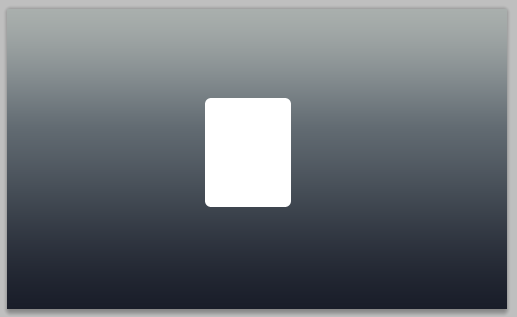
3.3. With white box as selection, go to gradient overlay (as explained in step 2.1). Again, make sure the opacity is 100%, style is linear and angle is 90 degrees. Click on the gradient and in the Gradient Editor, add color stops in this order: #e1e1e1 at 0% location, #ffffff at 49%, #e1e1e1 at 51% location and finally, #ffffff at 100% location.
3.3 Select the white square Now, set up the Gradient Overlay (like in step 2.1 before). Again, set the Opacity to 100%, the Style to Linear, and the Angle to 90 degrees. Click on the gradient, and in the gradient editor window, set the colors in order: #e1e1e1 at 0%, #ffffff at 49%, #e1e1e1 at 51%, and #e1e1e1 at 100% Set to #ffffff.
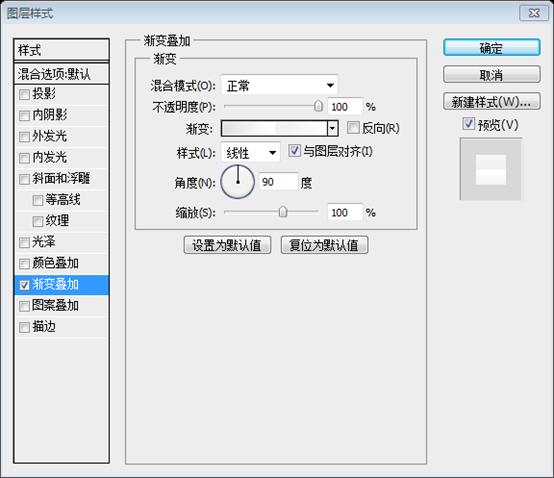
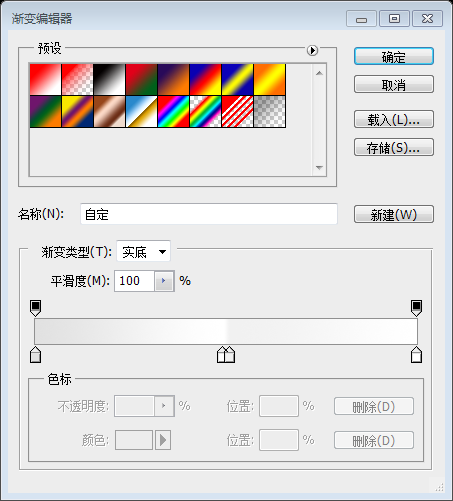
3.4. In the same box as gradient overlay, look for Drop Shadow and Stroke. We have to select them too. Drop shadow settings: Opacity - 45%, distance - 2 px, spread - 0 px and size - 3 px. Stroke settings: Size - 1 px, position - inside and color: #ffffff.
3.4在On the Gradient Overlay window, find Drop Shadow and Stroke. Set up as shown below. Drop Shadow settings: Opacity 45%, Distance 2px, Extension 0, Size 3px. Stroke settings: size 1px, position internal, color #ffffff.
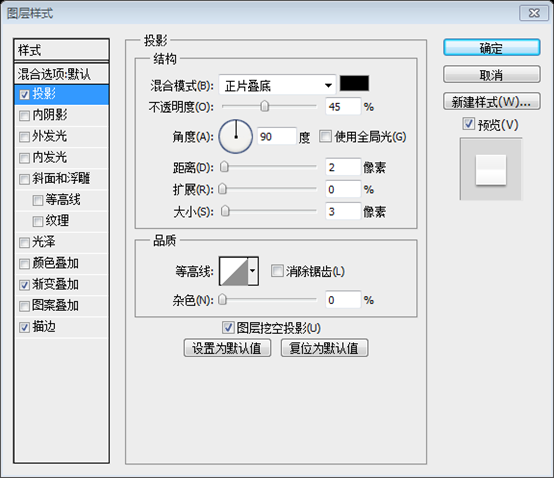
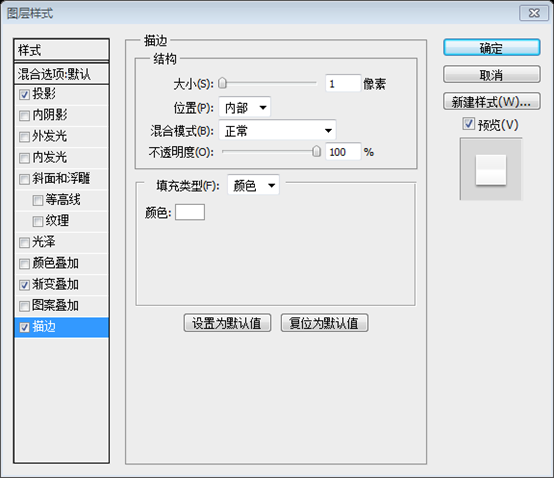

#4. Adding Separators to the box
4. Adding separators to the box
4.1. Click and hold the Rounded Rectangle Tool to select Line tool.4.1Click and hold the Rounded Rectangle Tool to select the Line Tool(198, 143, 86, 1) , just touches both sides of the white rectangle, as shown in the figure below, named "Deep Line"
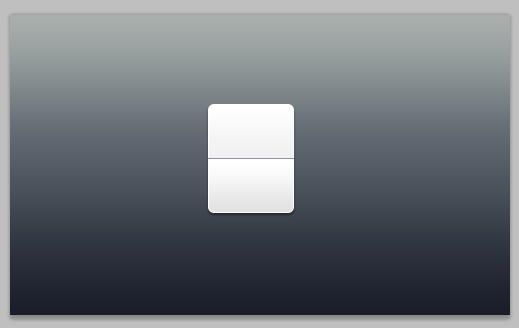
4.3. Right-click (ctrl-click in mac) "dark-sep" layer and select duplicate. Name it "white-sep". Press V on the keyboard to select Move tool, press bottom arrow to move " white-sep" downwards by 1 px and change it color to #ffffff.
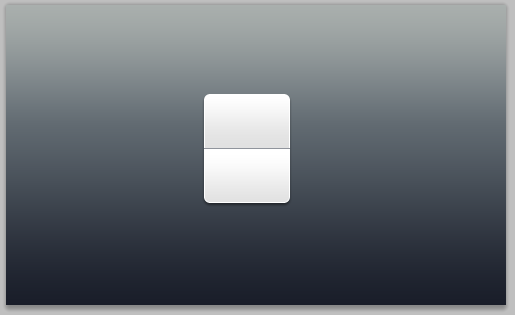
5. Adding text to complete the countdown
5. Adding text to complete the countdown number plate
5.1. Press T on the keyboard to select Text tool. We have chosen "Myriad Pro bold" in 80 pt size but feel free to select your favorite font here. Select the layer "white-box" and type in a digit or a letter in vertical and horizontal middle. We have typed in a 2.
5.1 Press T on the keyboard to select the text tool. Choose the font Myriad Pro bold and the font size 80pt, or choose a font you feel comfortable with. Select the white square layer and enter a number or text in the center. The input here is 2.

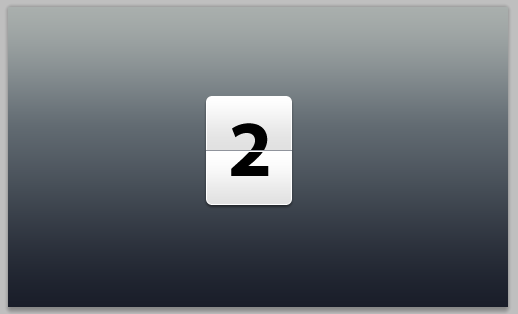
5.2. With text layer as selection, go to gradient overlay (as explained in step 2.1). Again, make sure the opacity is 100%, style is linear and angle is 90 degrees. Click on the gradient and in the Gradient Editor, add color stops in this order: #2d2d2d at 0% location, #474747 at 49 %, #2d2d2d at 51% location and finally, #474747 at 100% location.
5.2 Select the text layer and add a gradient overlay (like step 2.1 before). Again, set the Opacity to 100%, Style to Linear, and Angle to 90 degrees. Click on the gradient, and in the gradient editor window, set the colors in order: #2d2d2d at 0%, #474747 at 49%, #2d2d2d at 51%, and #2d2d2d at 100% Set to #474747.

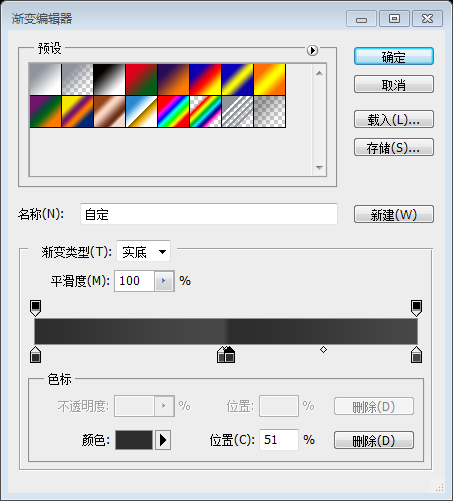
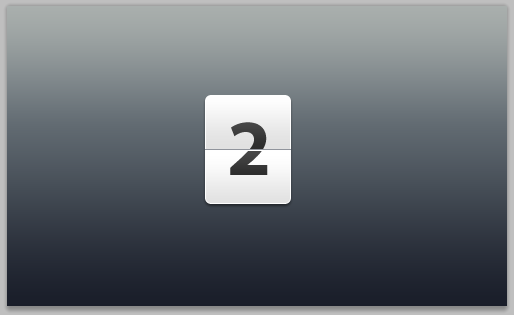
Here we have our countdown ready for usage as an element in broadcasting, collaterals or user interfaces.
The timing board has now been completed and can be used as billboard elements, collateral elements, or user interface elements.
Bonus Step - add reflection to the counter
Bonus Step: Add the reflection of the number plate
B.1. Select the layer "white-box" and duplicate this layer (step 4.3). Right click (ctrl-click in mac) and first select "rasterize layer" and then, "clear layer style" as shown below.
B.1Select the "white square" layer and copy the layer. Right-click and select "Rasterize Layer", then select "Clear Layer Style"
B.2. Press M on the keyboard to select Rectangular Marquee Tool and select the box 60% horizontally, from the bottom, like shown above. Go to Select > Modify > Feather and choose a feather radius of 20 px. We pressed "delete" 3 times to get the desired effect. You may choose as per your preference.
B.2 Press M on the keyboard to select the rectangular selection tool, and select the vertical 60% part from bottom to top, as shown above. Click: Select > Modify > Feather, select Feather Radius as 20px. Press the Delete key 3 times to get the desired effect. You can also set it according to your own ideas
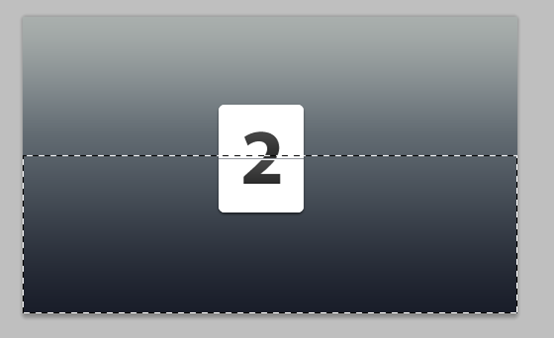
B.3. Press ctrl+d (cmd+d in mac) to deselect. Press V to go back to move tool and move the shape to the bottom of white box. Go to Edit > Transform > Flip vertical and change opacity of this layer to 20%.
B.3 Press Ctrl+D cancel selection. Press V to select the Move Tool and move it below the white square. Click: Edit > Transform > Vertical Flip (Note: This step seems to be redundant) . Set the opacity to 20%
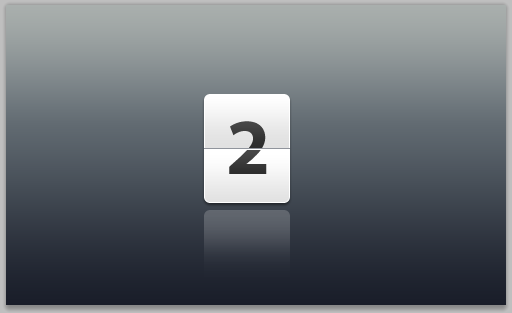
Show us what you made!
This is Another effect I made
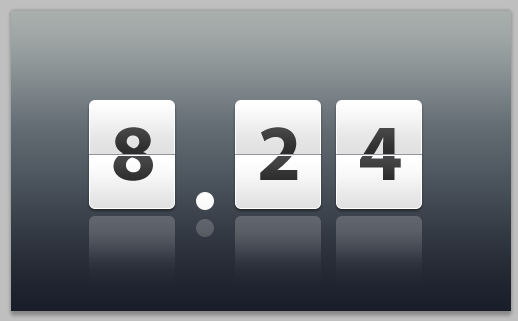
For more PS web design tutorials - Tips: Five steps to create countdown number cards in PS, please pay attention to the PHP Chinese website for related articles!

Hot AI Tools

Undresser.AI Undress
AI-powered app for creating realistic nude photos

AI Clothes Remover
Online AI tool for removing clothes from photos.

Undress AI Tool
Undress images for free

Clothoff.io
AI clothes remover

Video Face Swap
Swap faces in any video effortlessly with our completely free AI face swap tool!

Hot Article

Hot Tools

Notepad++7.3.1
Easy-to-use and free code editor

SublimeText3 Chinese version
Chinese version, very easy to use

Zend Studio 13.0.1
Powerful PHP integrated development environment

Dreamweaver CS6
Visual web development tools

SublimeText3 Mac version
God-level code editing software (SublimeText3)

Hot Topics
 1386
1386
 52
52
 What is the reason why PS keeps showing loading?
Apr 06, 2025 pm 06:39 PM
What is the reason why PS keeps showing loading?
Apr 06, 2025 pm 06:39 PM
PS "Loading" problems are caused by resource access or processing problems: hard disk reading speed is slow or bad: Use CrystalDiskInfo to check the hard disk health and replace the problematic hard disk. Insufficient memory: Upgrade memory to meet PS's needs for high-resolution images and complex layer processing. Graphics card drivers are outdated or corrupted: Update the drivers to optimize communication between the PS and the graphics card. File paths are too long or file names have special characters: use short paths and avoid special characters. PS's own problem: Reinstall or repair the PS installer.
 How to solve the problem of loading when PS is always showing that it is loading?
Apr 06, 2025 pm 06:30 PM
How to solve the problem of loading when PS is always showing that it is loading?
Apr 06, 2025 pm 06:30 PM
PS card is "Loading"? Solutions include: checking the computer configuration (memory, hard disk, processor), cleaning hard disk fragmentation, updating the graphics card driver, adjusting PS settings, reinstalling PS, and developing good programming habits.
 What are the common questions about exporting PDF on PS
Apr 06, 2025 pm 04:51 PM
What are the common questions about exporting PDF on PS
Apr 06, 2025 pm 04:51 PM
Frequently Asked Questions and Solutions when Exporting PS as PDF: Font Embedding Problems: Check the "Font" option, select "Embed" or convert the font into a curve (path). Color deviation problem: convert the file into CMYK mode and adjust the color; directly exporting it with RGB requires psychological preparation for preview and color deviation. Resolution and file size issues: Choose resolution according to actual conditions, or use the compression option to optimize file size. Special effects issue: Merge (flatten) layers before exporting, or weigh the pros and cons.
 How to speed up the loading speed of PS?
Apr 06, 2025 pm 06:27 PM
How to speed up the loading speed of PS?
Apr 06, 2025 pm 06:27 PM
Solving the problem of slow Photoshop startup requires a multi-pronged approach, including: upgrading hardware (memory, solid-state drive, CPU); uninstalling outdated or incompatible plug-ins; cleaning up system garbage and excessive background programs regularly; closing irrelevant programs with caution; avoiding opening a large number of files during startup.
 How to set password protection for export PDF on PS
Apr 06, 2025 pm 04:45 PM
How to set password protection for export PDF on PS
Apr 06, 2025 pm 04:45 PM
Export password-protected PDF in Photoshop: Open the image file. Click "File"> "Export"> "Export as PDF". Set the "Security" option and enter the same password twice. Click "Export" to generate a PDF file.
 How to use PS Pen Tool
Apr 06, 2025 pm 10:15 PM
How to use PS Pen Tool
Apr 06, 2025 pm 10:15 PM
The Pen Tool is a tool that creates precise paths and shapes, and is used by: Select the Pen Tool (P). Sets Path, Fill, Stroke, and Shape options. Click Create anchor point, drag the curve to release the Create anchor point. Press Ctrl/Cmd Alt/Opt to delete the anchor point, drag and move the anchor point, and click Adjust curve. Click the first anchor to close the path to create a shape, and double-click the last anchor to create an open path.
 How to solve the problem of loading when the PS opens the file?
Apr 06, 2025 pm 06:33 PM
How to solve the problem of loading when the PS opens the file?
Apr 06, 2025 pm 06:33 PM
"Loading" stuttering occurs when opening a file on PS. The reasons may include: too large or corrupted file, insufficient memory, slow hard disk speed, graphics card driver problems, PS version or plug-in conflicts. The solutions are: check file size and integrity, increase memory, upgrade hard disk, update graphics card driver, uninstall or disable suspicious plug-ins, and reinstall PS. This problem can be effectively solved by gradually checking and making good use of PS performance settings and developing good file management habits.
 How does PS feathering control the softness of the transition?
Apr 06, 2025 pm 07:33 PM
How does PS feathering control the softness of the transition?
Apr 06, 2025 pm 07:33 PM
The key to feather control is to understand its gradual nature. PS itself does not provide the option to directly control the gradient curve, but you can flexibly adjust the radius and gradient softness by multiple feathering, matching masks, and fine selections to achieve a natural transition effect.



